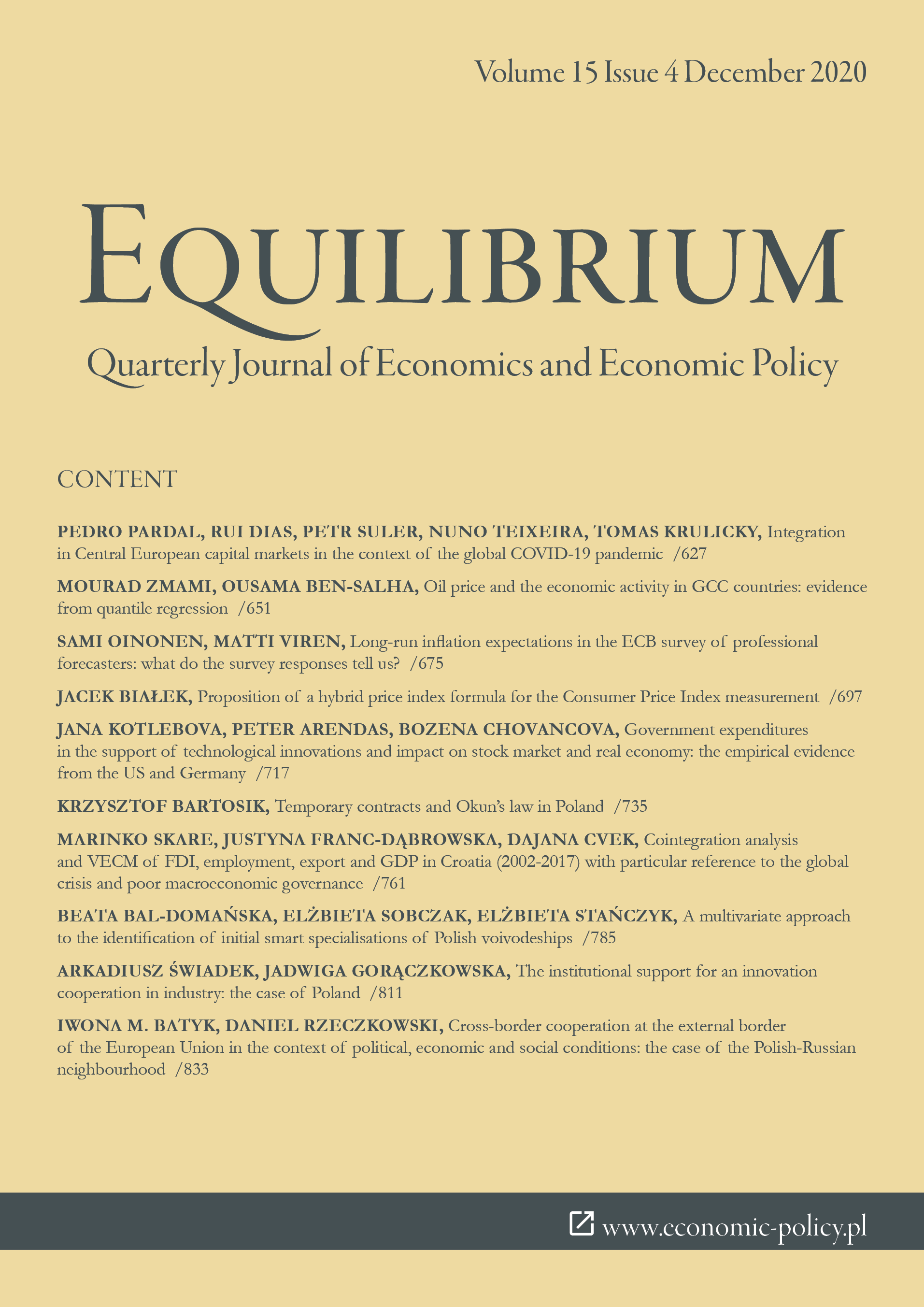Government expenditures in the support of technological innovations and impact on stock market and real economy: the empirical evidence from the US and Germany
DOI:
https://doi.org/10.24136/eq.2020.031Keywords:
technological innovations, stock market, government expenditures on R&D, patents and inventionsAbstract
Research background: The current changes in the global stock markets are related to the next wave of the industrial revolution ?Industry 4.0?. It is expected that the Industry 4.0 will lead to an acceleration of the innovation process and growth of volumes of tailor-made products. The stock markets started to react to the upcoming technological changes over the last decade, which are reflected by the changes in the composition of the major stock indices where the technological sector started to grow in importance. But innovations are not only connected with the specialized technological sector, but they are also of direct concern to the whole spectrum of economic entities. Besides the private investments that are usually allocated via the stock market, also the public sector investments play an important role.
Purpose of the article: The aim of this paper is to investigate the relationship between government expenditures on research and development (R&D) and stock markets (and GDP) in the US and in Germany.
Methods: We use the tools of descriptive analysis as well as correlation and regression methods of estimation.
Findings & Value added: Our research confirms that the collection of data on R&D on annual basis for Germany and the US is insufficient for analytical and systemic management purposes. The real effects of investments in the R&D are time lagged. The regression analysis of annual data confirms only the statistical importance of patent applications as well as interest rate and stock index as independent variables in explanation of variability of real economy growth during the 1985?2017 period. Our model did not prove the significance of government expenditures. We can explain it, among others, by the fact that governments do not pay sufficient attention to the challenges yet, which are associated with the Industry 4.0, especially in the US, where the government expenditures in R&D gradually decrease. The governments in both economies try to increase their support, but fiscal sustainability is a limiting factor.
Downloads
References
Azoulay, P., Graff Zivin, J. S., Li, D., & Sampat, B. N. (2019). Public R&D investments and private-sector patenting: evidence from NIH funding rules. Review of Economic Studies, 86(1). doi: 10.1093/restud/rdy034.
DOI: https://doi.org/10.1093/restud/rdy034
View in Google Scholar
Blanco, F. A., Delgado, F. J., & Presno, M. J. (2020). R&D expenditures in the EU: convergence or divergence? Economic Research-Ekonomska Istraživanja: 33(1). doi: 10.1080/1331677X.2020.1756371.
DOI: https://doi.org/10.1080/1331677X.2020.1756371
View in Google Scholar
Brown, J. R., Martinsson, G., & Petersen, B. C. (2017). Stock markets, credit markets, and technology-led growth. Journal of Financial Intermediation, 32. doi: 10.1016/j.jfi.2016.07.002.
DOI: https://doi.org/10.1016/j.jfi.2016.07.002
View in Google Scholar
Canace, T. G., Jackson, S. B., & Ma, T. (2018). R&D investments, capital expenditures, and earnings thresholds. Review of Accounting Studies, 23(1). doi: 10.1007/s11142-017-9428-9.
DOI: https://doi.org/10.1007/s11142-017-9428-9
View in Google Scholar
Chatziantoniou, I., Duffy, D., & Filis, G. (2013). Stock market response to monetary and fiscal policy shocks: multi-country evidence. Economic Modelling, 30. doi: 10.1016/j.econmod.2012.10.005.
DOI: https://doi.org/10.1016/j.econmod.2012.10.005
View in Google Scholar
Chen, S. S., Chen, Y. S., Liang, W. L., & Wang, Y. (2013). R&D spillover effects and firm performance following R&D increases. Journal of Financial and Quantitative Analysis, 48(5). doi: 10.1017/S0022109013000574.
DOI: https://doi.org/10.1017/S0022109013000574
View in Google Scholar
Gomes, F., Michaelides, A., & Polkovnichenko, V. (2013). Fiscal policy and asset prices with incomplete markets. Review of Financial Studies, 26(2). doi: 10.1093/rfs/hhs110.
DOI: https://doi.org/10.1093/rfs/hhs110
View in Google Scholar
Greenhalgh, Ch. (2016). Science, technology, innovation and IP in India: new directions and prospects. Economic Change and Restructuring, 49. doi: 10.1007/s10644-015-9165-7.
DOI: https://doi.org/10.1007/s10644-015-9165-7
View in Google Scholar
Ivanova, E., & Cepel, M. (2018). The impact of innovation performance on the competitiveness of the Visegrad 4 countries. Journal of Competitiveness, 10(1). doi: 10.7441/joc.2018.01.04.
DOI: https://doi.org/10.7441/joc.2018.01.04
View in Google Scholar
Jiang, Y. (2016). Market expansion and R&D externality effect. International Journal of Business, 21(4).
View in Google Scholar
Kim, S. J., Kim, E. M., Suh, Y. & Zheng, Z. (2016). The effect of service innovation on R&D activities and government support systems: the moderating role of government support systems in Korea. Journal of Open Innovation: Technology, Market, and Complexity, 2(1). doi: 10.1186/s40852-016-0032-1.
DOI: https://doi.org/10.1186/s40852-016-0032-1
View in Google Scholar
Link, A. N. (2018). The impact of public R&D investments on patenting activity: technology transfer at the U.S. Environmental Protection Agency. Economics of Innovation and New Technology, 28(5). doi: 10.1080/10438599.2018.154 2772.
DOI: https://doi.org/10.1080/10438599.2018.1542772
View in Google Scholar
Laird, F. N. (2020). Sticky policies, dysfunctional systems: path dependency and the problems of government funding for Science in the United States. Minerva. doi:10.1007/s11024-020-09409-02.
DOI: https://doi.org/10.1007/s11024-020-09409-2
View in Google Scholar
Mbanga, C., & Darrat, A. F. (2016). Fiscal policy and the US stock market. Review of Quantitative Finance and Accounting, 47(4). doi: 10.1007/s11156-015-0528-y.
DOI: https://doi.org/10.1007/s11156-015-0528-y
View in Google Scholar
Nogare, G. E. D., Schulz, J. R. d. S., Silveira, F. d., & Ruppenthal, J. E. (2019). Analysis of the relationship between innovation, stock market and economic growth in the case of China. Revista Ciencias Administrativas, 25(1). doi: 10.5020/2318-0722.2019.6597.
DOI: https://doi.org/10.5020/2318-0722.2019.6597
View in Google Scholar
OECD (2019). https://stats.oecd.org.
View in Google Scholar
The World Bank (2019). https://data.worldbank.org.
View in Google Scholar
Strielkowski, W., Gryshova, I., & Kalyugina, S. (2017). Modern technologies in public administration management: a comparison of Estonia, India and United Kingdom. Administratie si Management Public, 28.
View in Google Scholar
Xu, S., He, X., & Xu, L. (2019). Market or government: who plays a decisive role in R&D resource allocation? China Finance Review International, 9(1). doi: 10.1108/CFRI-08-2017-0190.
DOI: https://doi.org/10.1108/CFRI-08-2017-0190
View in Google Scholar
Zhao, Y. (2019). Research and Implications on OECD Governments? Procurement Policy to Promote Technology Innovation. International Journal of Sustainability Management and Information Technologies, 5(1). doi: 10.11648 /j.ijsmit.20190501.13 .
DOI: https://doi.org/10.11648/j.ijsmit.20190501.13
View in Google Scholar
Downloads
Published
How to Cite
Issue
Section
License
Copyright (c) 2020 Equilibrium. Quarterly Journal of Economics and Economic Policy

This work is licensed under a Creative Commons Attribution 4.0 International License.






